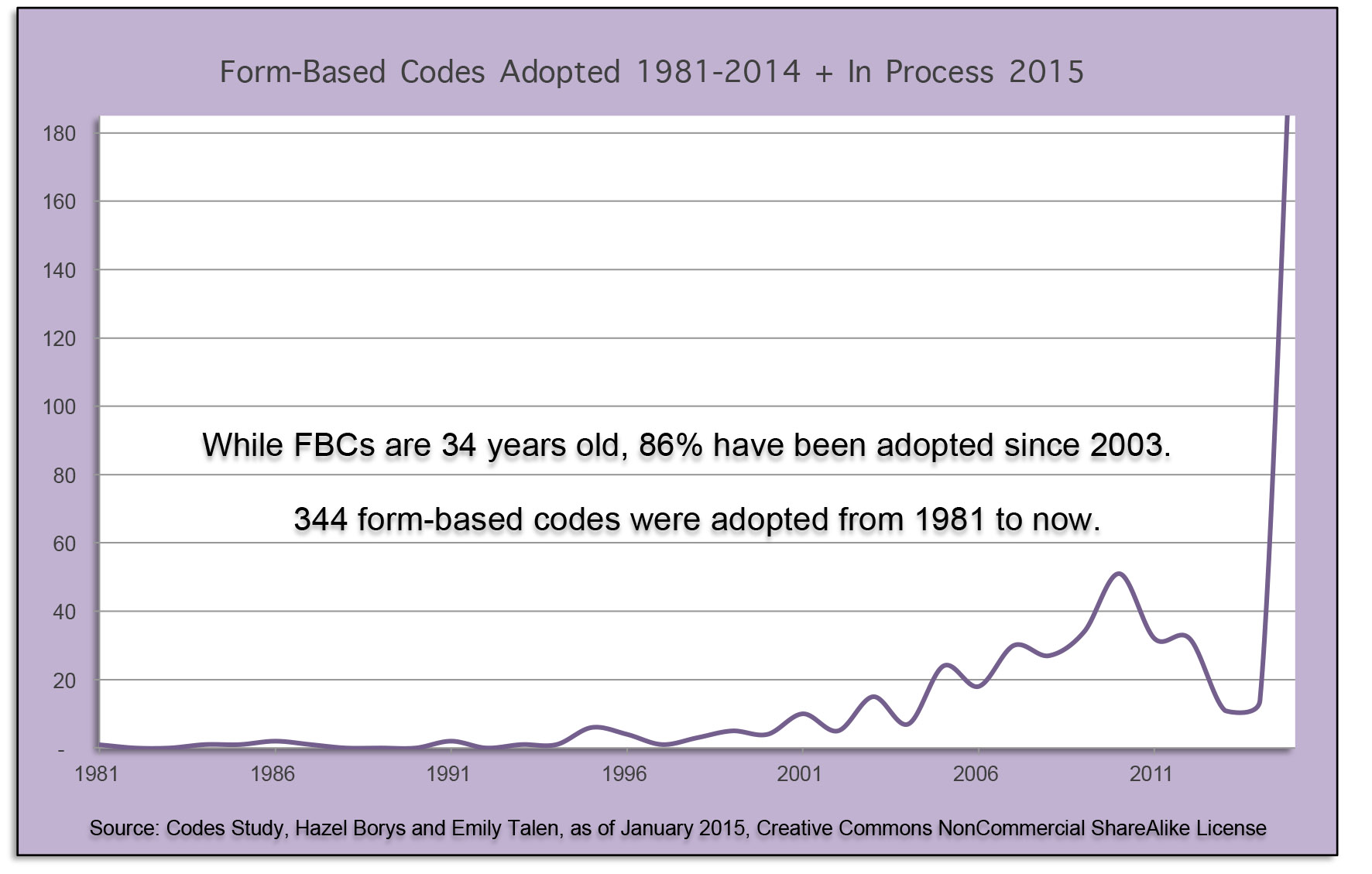The forward march of form-based codes

Click for higher resolution view.
The latest update of the of the Codes Study led by Hazel Borys and Emily Talen, with contributions by public and private planners, tracks 584 codes internationally that meet criteria established by the Form-Based Codes Institute, as well as an additional 16 form-based guidelines. As of January, 2015, 344 of these codes are adopted with others in progress. Eighty-six percent have been adopted since 2003.
The number of form-based codes (FBCs) rose 22 percent from the last Codes Study update in May of 2013 (480 codes, 279 adopted).
Even as the latest update was released, practitioners were adding to the list.
What’s the difference between a form-based code and conventional zoning? All codes shape the built form of communities. Conventional codes are organized around separation of uses and the form is a byproduct. With a FBC, the form is the central organizing principle. It is intentional and based on a community vision.
Why form-based codes? Because our current laws tend to separate where we live from where we work, learn, and shop, and insist on big, fast roads to connect them all, the authors report. “As a result, North Americans spend more hours in their cars than anyone on earth, and a growing number of communities are working to do something about it.”
The growing number of FBCs have clear regional concentrations. Big city adopters include Miami, Nashville, Dallas, Ft. Worth, Denver, Albuquerque, El Paso, Memphis, Baltimore, Tulsa, Portland, Cincinnati, Philadelphia, Los Angeles, San Diego, Austin, Chattanooga, Atlanta, Jacksonville, Calgary, Abu Dhabi, Dammam. Many small to medium-sized communities have adopted FBCs as well. FBCs have been applied to hamlets as small as 35 acres and 100 people.
The growth in FBCs represents “a tremendous shift in business as usual,” the authors report. The reasons for adopting these codes range from improving quality-of-life to becoming more economically competitive.
The Codes Study tracks SmartCodes, other Transect-based codes, and other form-based codes that meet FBCI criteria:
- Is the code’s focus primarily on regulating urban form and less on land use?
- Is the code regulatory rather than advisory?
- Does the code emphasize standards and parameters for form with predictable physical outcomes (build-to lines, frontage type requirements, etc.) rather than relying on numerical parameters (FAR, density, etc.) whose outcomes are impossible to predict?
- Does the code require private buildings to shape public space through the use of building form standards with specific requirements for building placement?
- Does the code promote and/or conserve an interconnected street network and pedestrian-scaled blocks?
- Are regulations and standards keyed to specific locations on a regulating plan?
- Are the diagrams in the code unambiguous, clearly labeled, and accurate in their presentation of spatial configurations?
The Codes Study also tracks initiatives and guidelines that may assist in the formulation of form-based codes. When these do not meet FBCI criteria, they are listed as form-based guidelines.
Click links within the full Codes Study to go to project pages and to view codes. If you have updates or additions, please let the authors know to update the Google Maps directly.
Collaborative Google Maps are part of the Codes Study: SmartCodes Adopted | SmartCodes in Progress | Other Form-Based Codes
As you add your work, use purple markers for other form-based codes, green markers for SmartCodes adopted, and yellow markers for SmartCodes in progress.
The Codes Study generally does not track developer-driven form-based codes. However, these collaborative maps detail Traditional Neighborhood Developments of comparable character: Eastern US | Western US | Canada
As you add your work, please use blue markers for greenfield development and turquoise for infill.




